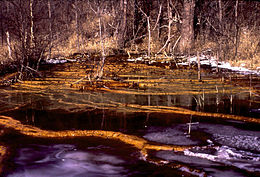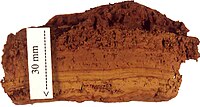| Ferrihydrite | |
|---|---|
 Mine drainage from Ohio. The orange coating on the logs is ferrihydrite. | |
| General | |
| Category | Oxide minerals |
| Formula (repeating unit) | (Fe3+)2O3·0.5H2O |
| IMA symbol | Fhy[1] |
| Strunz classification | 4.FE.35 |
| Dana classification | 04.03.02.02 |
| Crystal system | Hexagonal |
| Crystal class | Dihexagonal pyramidal (6mm) H-M symbol: (6mm) |
| Space group | P63mc |
| Unit cell | a = 5.958, c = 8.965 [Å]; Z = 1 |
| Identification | |
| Formula mass | 168.70 g/mol |
| Color | Dark brown, yellow-brown |
| Crystal habit | Aggregates, microscopic crystals |
| Streak | Yellow-brown |
| Diaphaneity | Opaque |
| Density | 3.8 g/cm3 |
| References | [2][3][4][5] |

Ferrihydrite (Fh) is a widespread hydrous ferric oxyhydroxide mineral at the Earth's surface,[6][7] and a likely constituent in extraterrestrial materials.[8] It forms in several types of environments, from freshwater to marine systems, aquifers to hydrothermal hot springs and scales, soils, and areas affected by mining. It can be precipitated directly from oxygenated iron-rich aqueous solutions, or by bacteria either as a result of a metabolic activity or passive sorption of dissolved iron followed by nucleation reactions.[9] Ferrihydrite also occurs in the core of the ferritin protein from many living organisms, for the purpose of intra-cellular iron storage.[10][11]
Structure
[edit]Ferrihydrite only exists as a fine grained and highly defective nanomaterial. The powder X-ray diffraction pattern of Fh contains two scattering bands in its most disordered state, and a maximum of six strong lines in its most crystalline state. The principal difference between these two diffraction end-members, commonly named two-line and six-line ferrihydrites, is the size of the constitutive crystallites.[12][13] The six-line form has been classified as a mineral by the IMA in 1973[14] with the nominal chemical formula 5Fe
2O
3·9H
2O.[15] Other proposed formulas are Fe
5HO
8·4H
2O[16] and Fe
2O
3·2FeO(OH)·2.6H
2O.[17] However, its formula is fundamentally indeterminate as its water content is variable. The two-line form is also called hydrous ferric oxides (HFO).
Due to the nanoparticulate nature of ferrihydrite, the structure has remained elusive for many years and is still a matter of controversy.[18][19][20] Drits et al., using X-ray diffraction data,[12] proposed in 1993 a multiphase structure model for six-line ferrihydrite with three components: (1) defect-free crystallites (f-phase) with double-hexagonal stacking of oxygen and hydroxyl layers (ABAC sequence) and disordered octahedral Fe occupancies, (2) defective crystallites (d-phase) with a short-range feroxyhite-like (δ-FeOOH) structure, and (3) subordinate ultradisperse hematite (α-Fe2O3). The diffraction model has been confirmed in 2002 by neutron diffraction,[21] and the three components were observed by high-resolution transmission electron microscopy.[22][23][24] A single phase model for both ferrihydrite and hydromaghemite[25] has been proposed by Michel et al.,[26][27] in 2007–2010, based on pair distribution function (PDF) analysis of x-ray total scattering data. The structural model, isostructural with the mineral akdalaite (Al10O14(OH)2), contains 20% tetrahedrally and 80% octahedrally coordinated iron. Manceau et al. showed in 2014[28] that the Drits et al.[12] model reproduces the PDF data as well as the Michel et al.[26] model, and he suggested in 2019[20] that the tetrahedral coordination arises from maghemite and magnetite impurities observed by electron microscopy.[23][29][30]
Porosity and environmental absorbent potential
[edit]Because of the small size of individual nanocrystals, Fh is nanoporous yielding large surface areas of several hundred square meters per gram.[31] In addition to having a high surface area to volume ratio, Fh also has a high density of local or point defects, such as dangling bonds and vacancies. These properties confer a high ability to adsorb many environmentally important chemical species, including arsenic, lead, phosphate, and organic molecules (e.g., humic and fulvic acids).[32][33][34][35] Its strong and extensive interaction with trace metals and metalloids is used in industry, at large-scale in water purification plants, as in North Germany and to produce the city water at Hiroshima, and at small scale to clean wastewaters and groundwaters, for example to remove arsenic from industrial effluents and drinking water.[36][37][38][39][40] Its nanoporosity and high affinity for gold can be used to elaborate Fh-supported nanosized Au particles for the catalytic oxidation of CO at temperatures below 0 °C.[41] Dispersed six-line ferrihydrite nanoparticles can be entrapped in a vesicular state to increase their stability.[42]
Metastability
[edit]Ferrihydrite is a metastable mineral. It is known to be a precursor of more crystalline minerals like hematite and goethite[43][44][45][46] by aggregation-based crystal growth.[47][48] However, its transformation in natural systems generally is blocked by chemical impurities adsorbed at its surface, for example silica as most of natural ferrihydrites are siliceous.[49]
Under reducing conditions as those found in gley soils, or in deep environments depleted in oxygen, and often with the assistance of microbial activity, ferrihydrite can be transformed in green rust, a layered double hydroxide (LDH), also known as the mineral fougerite. However, a short exposure of green rust to atmospheric oxygen is sufficient to oxidize it back to ferrihydrite, making it a very elusive compound.
-
Ferrihydrite precipitate from coal mine water
-
Spring in the Zillertaler Alps with Fh precipitate
-
Seepage of iron-rich water
-
Transformation of ferrihydrite (top) to goethite (bottom)
-
Water treatment plant using the slow sand filter technology to treat raw water
-
Tricolor (RGB) X-ray fluorescence image of the distribution of As (red), Fe (green), and Mn (blue) in coated quartz grains from a water treatment sand bed[39]
See also
[edit]Better crystallized and less hydrated iron oxy-hydroxides are amongst others:
References
[edit]- ^ Warr, L.N. (2021). "IMA–CNMNC approved mineral symbols". Mineralogical Magazine. 85 (3): 291–320. Bibcode:2021MinM...85..291W. doi:10.1180/mgm.2021.43. S2CID 235729616.
- ^ "Ferrihydrite Mineral Data". webmineral.com. Retrieved 2011-10-24.
- ^ "Ferrihydrite mineral information and data". mindat.org. Retrieved 2011-10-24.
- ^ "Handbook of Mineralogy" (PDF). Archived from the original (PDF) on 2012-07-16. Retrieved 2011-10-24.
- ^ Mineralienatlas
- ^ J. L. Jambor, J.E. Dutrizac, Chemical Reviews, 98, 22549–2585 (1998)
- ^ R. M. Cornell R.M., U. Schwertammn, The iron oxides: structure, properties, reactions, occurrences and uses, Wiley–VCH, Weinheim, Germany (2003)
- ^ M. Maurette, Origins of Life and Evolution of the Biosphere, 28, 385–412 (1998)
- ^ D. Fortin, S. Langley, Earth-Science Reviews, 72, 1–19 (2005)
- ^ N. D. Chasteen, P. M. Harrison, Journal of Structural Biology, 126, 182–194 (1999)
- ^ A. Lewin, G. R. Moore, N. E. Le Brun, Dalton Transactions, 22, 3597–3610 (2005)
- ^ a b c V. A. Drits, B. A. Sakharov, A. L. Salyn, et al. Clay Minerals, 28, 185–208 (1993)
- ^ A. Manceau A., V. A. Drits, Clay Minerals, 28, 165–184 (1993)
- ^ F. V. Chuckrov, B. B. Zvyagin, A.I. Gorshov, et al. International Geology Review, 16, 1131–1143 (1973)
- ^ M. Fleischer, G. Y. Chao, A. Kato (1975): American Mineralogist, volume 60
- ^ Kenneth M Towe and William F Bradley (1967): "Mineralogical constitution of colloidal 'hydrous ferric oxides'". Journal of Colloid and Interface Science, volume 24, issue 3, pages 384–392. doi:10.1016/0021-9797(67)90266-4
- ^ J. D. Russell (1979): "Infrared spectroscopy of ferrihydrite: evidence for the presence of structural hydroxyl groups". Clay Minerals, volume 14, issue 2, pages 109–114. doi:10.1180/claymin.1979.014.2.03
- ^ D. G. Rancourt, J. F. Meunier, American Mineralogist, 93, 1412–1417 (2008)
- ^ A. Manceau. American Mineralogist, 96, 521–533 (2011)
- ^ a b A. Manceau ACS Earth and Space Chemistry, 4, 379–390 (2020). doi:10.1021/acsearthspacechem.9b00018
- ^ E. Jansen, A. Kyek, W. Schafer, U. Schwertmann. Appl. Phys. A: Mater. Sci. Process., 74, S1004–S1006 (2002)
- ^ D.E. Janney, J.M. Cowley, P.R. Buseck. American Mineralogist, 85, 1180–1187 (2000)
- ^ a b D.E. Janney, J.M. Cowley, P.R. Buseck. American Mineralogist, 86, 327–335 (2001).
- ^ A. Manceau. Clay Minerals, 44, 19–34 (2009)
- ^ V. Barron, J. Torrent, E. de Grave American Mineralogist, 88, 1679–1688 (2003)
- ^ a b F. M. Michel, L. Ehm, S. M. Antao, et al. Science, 316, 1726–1729 (2007)
- ^ F. M. Michel, V. Barron, J. Torrent, et al. PNAS, 107, 2787–2792 (2010)
- ^ A. Manceau, S. Skanthakumar, S. Soderholm, American Mineralogist, 99, 102–108 (2014). doi:10.2138/am.2014.4576
- ^ X. J. M. Cowley, D. E. Janney, R. C. Gerkin, P. R. Buseck, P. R., Journal of Structural Biology 131, 210–216 (2000)
- ^ Z D. E. Janney, J. M. Cowley, P. R. Buseck, Clays Clay Miner., 48, 111–119 (200)
- ^ T. Hiemstra, W. H. Van Riemsdijk, Geochimica et Cosmochimica Acta, 73, 4423–4436 (2009)
- ^ A. L. Foster, G. E. Brown, T. N. Tingle, et al. American Mineralogist, 83, 553–568 (1998)
- ^ A. H. Welch, D. B. Westjohn, D. R. Helsel, et al. Ground Water, 38, 589–604 (2000)
- ^ M. F. Hochella, T. Kasama, A. Putnis, et al. American Mineralogist, 90, 718–724 (2005)
- ^ D. Postma, F. Larsen, N. T. M. Hue, et al. Geochimica et Cosmochimica Acta, 71, 5054–5071 (2007)
- ^ P. A. Riveros J. E. Dutrizac, P. Spencer, Canadian Metallurgical Quarterly, 40, 395–420 (2001)
- ^ O. X. Leupin S. J. Hug, Water Research, 39, 1729–1740 (2005)
- ^ S. Jessen, F. Larsen, C. B. Koch, et al. Environmental Science & Technology, 39, 8045–8051 (2005)
- ^ a b A. Manceau, M. Lanson, N. Geoffroy, Geochimica et Cosmochimic Acta, 71, 95–128 (2007)
- ^ D. Paktunc, J. Dutrizac, V. Gertsman, Geochimica et Cosmochimica Acta, 72, 2649–2672
- ^ N. A. Hodge, C. J. Kiely, R. Whyman, et al. Catalysis Today, 72, 133–144 (2002)
- ^ L. Gentile, Journal of Colloid and Interface Science, https://doi.org/10.1016/j.jcis.2021.09.192 (2021)
- ^ U. Schwertmann, E. Murad, Clays Clay Minerals, 31, 277 (1983)
- ^ U. Schwertmann, J. Friedl, H. Stanjek, Journal of Colloid and Interface Science, 209, 215–223 (1999)
- ^ U. Schwertmann, H. Stanjek, H.H. Becher, Clay Miner. 39, 433–438 (2004)
- ^ Y. Cudennec, A. Lecerf (2006). "The transformation of ferrihydrite into goethite or hematite, revisited" (PDF). Journal of Solid State Chemistry. 179 (3): 716–722. Bibcode:2006JSSCh.179..716C. doi:10.1016/j.jssc.2005.11.030. S2CID 93994327.
- ^ W. R. Fischer, U. Schwertmann, Clays and Clay Minerals, 23, 33 (1975)
- ^ J. F. Banfield, S. A. Welch, H. Z. Zhang, et al. Science, 289, 751–754 (2000)
- ^ L. Carlson, U. Schwertmann, Geochimica et Cosmochimica Acta, 45, 421-429 (1981)





![Tricolor (RGB) X-ray fluorescence image of the distribution of As (red), Fe (green), and Mn (blue) in coated quartz grains from a water treatment sand bed[39]](http://upload.wikimedia.org/wikipedia/commons/thumb/4/49/Qtz_coating_rAsgFebMn.jpg/171px-Qtz_coating_rAsgFebMn.jpg)